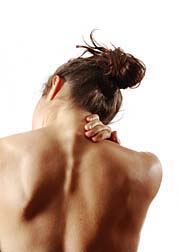How Massage Works to Relieve Pain
The Massage Manual- March editionPosted in the March |LIVE|BODY monthly newsletterMost people will tell you that massage helps to relieve their pain and tension, but how exactly does it do that? Your body is a very complex instrument and works in ways even the most educated scientists cannot understand. Through research and clinical trials we have come to know a little bit about how exactly massage therapy relieves pain. After being asked this exact question by a client and being a bit stumped on how to explain it, I set about writing this article to break it down.

One of the most basic ways it works is the increase of circulation. An RMT will always have the deep, broad strokes going towards the heart to encourage healthy venous return. The light sweeping strokes and deeper kneading act like squeezing a sponge in water; fresh blood and lymph flow back into the area as the pressure is released. Lymph carries white blood cells and is the highway of the body's immune system. Encouraging lymph flow helps to literally flush out toxins and bacteria.
Another way that massage reduces pain is though the nervous system. This works in multiple ways. Manual touch releases your natural painkillers such as endorphins and mood-enhancing serotonin as well as reducing the amount of cortisol, the stress hormone. When a muscle or tendon (the part of muscle which attaches to the bone) is kneaded and stretched, it activates a part of the muscle called the muscle spindle. This structure communicates with the brain, which reads the change as being excessive tension, and it tells the muscle to relax. Effectively, this "tricks" the brain into releasing the muscle. A clear example of how this works is how quickly and effectively a massage therapist can release a spasm or a "cramp".
One more way that massage therapy works through the nervous system is by the gate control theory, essentially "distracting" your brain from the pain. Your brain is constantly receiving pain signals (among others) from the injured muscle, but it can only process so much information at once. Manual therapy sends its sensations to the brain faster, effectively distracting it so you don't feel any pain, sort of like how scratching an itch or rubbing a bruised elbow works. Certainly this is somewhat temporary relief, but it can actually de-rail the escalating cycle of pain. In the long run, the less pain signals your brain receives from the muscle, the quicker you will experience relief, and the less likely it is that the pain will become chronic. This is one reason why regular massage is more effective than sporadic treatments.
In addition to these effects, massage has been proven to increase restorative sleep, increase relaxation and decrease stress, all of which have a surprisingly large effect on your pain sensitivity and healing.
For more information, check out these informative links:
How Does Massage Work?
Effectiveness of Massage Therapy for Chronic, Non-malignant Pain
Massage Better Than Relaxation Therapy for Fibromyalgia
Take care of yourself,
Laura


No comments:
Post a Comment